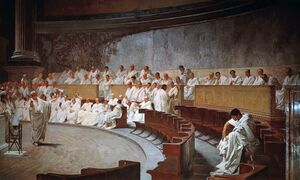مجلس الشيوخ الروماني
مجلس الشيوخ الروماني أو Senatus السيناتوس، هو السلطة التشريعية العليا في الجمهورية الرومانية التي نشأت عام 509 ق.م واستمرت حتى عند تحول روما إلى إمبراطورية علم 27 ق.م ولكنها ضعفت لصالح الامبراطور واستمر حتى تقسيم الإمبراطورية إلى جزئين شرقي وغربي.
. . . . . . . . . . . . . . . . . . . . . . . . . . . . . . . . . . . . . . . . . . . . . . . . . . . . . . . . . . . . . . . . . . . . . . . . . . . . . . . . . . . . . . . . . . . . . . . . . . . . . . . . . . . . . . . . . . . . . . . . . . . . . . . . . . . . . . . . . . . . . . . . . . . . . . . . . . . . . . . . . . . . . . . .
مسؤوليات المجلس
كان المجلس مسؤلا عن تعيين الرومان في المناصب المدنية والعسكرية المهمة وتوجية الجيوش واعلان الحروب وصرف المكافآت للجنود وقوادهم والاشراف المباشر على انتخاب القنصل ومحاسبة القناصل والقنصل أو القنصلان هما من يحكم الجمهورية.
الأعضاء: العدد والانتخاب
وكان المجلس يتكون من 300 عضو من الطبقة الاستقراطية فقط ومن الرجال, لكن هذا العدد يزيد أو يقل في العديد من المناسبات وابرزها عندما زاد الديكتاتور سولا من عدد الاعضاء إلى الضعف في عام 78 ق.م. كان الاعضاء معظمهم منتخب والجزء الآخر مرشح للمنصب وذلك على حسب المكانة الاجتماعية أو السمعة. كان لمجلس الشيوخ تأثير كبير ومهم في تاريخ روما منذ تأسيسه.
أول مجلس شيوخ بالأرض
يعتبر مجلس الشيوخ الروماني أول مجلس شيوخ وقد اخذت الدول الديمقراطية الحديثة نفس مبادئه واسمه كما هو الحال في مجلس الشيوخ الأمريكي والأرجنتيني والفرنسي.
انظر أيضاً
الهامش
المراجع
- Abbott, Frank Frost (1901). A History and Description of Roman Political Institutions. Elibron Classics. ISBN 0-543-92749-0.
- Byrd, Robert (1995). The Senate of the Roman Republic. US Government Printing Office Senate Document 103–23. ISBN 0-16-058996-7.
- Cicero, Marcus Tullius (1841). The Political Works of Marcus Tullius Cicero: Comprising his Treatise on the Commonwealth; and his Treatise on the Laws. Vol. Vol. 1 (Translated from the original, with Dissertations and Notes in Two Volumes By Francis Barham, Esq ed.). London: Edmund Spettigue.
{{cite book}}:|volume=has extra text (help) - Holland, Tom (2005). Rubicon: The Last Years of the Roman Republic. Random House Books. ISBN 1-4000-7897-0.
- Lintott, Andrew (1999). The Constitution of the Roman Republic. Oxford University Press. ISBN 0-19-926108-3.
- Polybius (1823). The General History of Polybius: Translated from the Greek. Vol. Vol. 2 (Fifth ed.). Oxford: Printed by W. Baxter.
{{cite book}}:|volume=has extra text (help) - Taylor, Lily Ross (1966). Roman Voting Assemblies: From the Hannibalic War to the Dictatorship of Caesar. The University of Michigan Press. ISBN 0-472-08125-X.
- Taylor, Lily Ross; Scott, Russell T (1969). "Seating Space in the Roman Senate and the Senatores Pedarii". Transactions and Proceedings of the American Philological Association. The Johns Hopkins University Press. 100: 529–582. doi:10.2307/2935928. JSTOR 2935928.
للاستزادة
- Cambridge Ancient History, Volumes 9–13.
- Cameron, A. The Later Roman Empire, (Fontana Press, 1993).
- Crawford, M. The Roman Republic, (Fontana Press, 1978).
- Gruen, E. S. "The Last Generation of the Roman Republic" (U California Press, 1974)
- Ihne, Wilhelm. Researches Into the History of the Roman Constitution. William Pickering. 1853.
- Johnston, Harold Whetstone. Orations and Letters of Cicero: With Historical Introduction, An Outline of the Roman Constitution, Notes, Vocabulary and Index. Scott, Foresman and Company. 1891.
- Millar, F. The Emperor in the Roman World, (Duckworth, 1977, 1992).
- Mommsen, Theodor. Roman Constitutional Law. 1871–1888
- Polybius. The Histories
- Tighe, Ambrose. The Development of the Roman Constitution. D. Apple & Co. 1886.
- Von Fritz, Kurt. The Theory of the Mixed Constitution in Antiquity. Columbia University Press, New York. 1975.
